Subaru Forester 2019-2025 Owners Manual / Starting and operating / Reverse Automatic Braking (RAB) system (if equipped) / Operating conditions
Subaru Forester: Reverse Automatic Braking (RAB) system (if equipped) / Operating conditions
The Reverse Automatic Braking (RAB) system will operate when all of the following conditions are met.
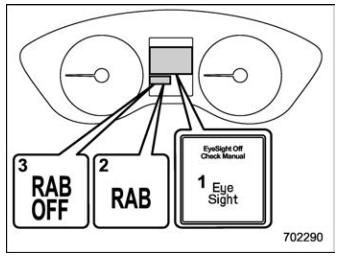
- EyeSight warning indicator
- RAB warning indicator
- RAB OFF indicator
- The ignition switch is in the “ON” position.
- The EyeSight warning indicator is off.
- The RAB warning indicator is off.
- The RAB OFF indicator is off.
- The Reverse Automatic Braking (RAB) system is set to on.
- The select lever is in the “R” position.
- The vehicle speed is between 1 to 9 mph (1.5 to 15 km/h).
NOTE
- In the following cases, the Reverse
Automatic Braking (RAB) system will
not operate. Promptly contact a
SUBARU dealer to have the system
inspected.
- The EyeSight warning indicator is illuminated.
- The RAB warning indicator is illuminated.
- When the RAB OFF indicator is illuminated, the Reverse Automatic Braking (RAB) system cannot be operated.
- In the following cases, the system
may not be able to properly detect an
obstacle. Promptly contact a SUBARU
dealer to have the system inspected.
- A sticker, paint, or a chemical is applied to the sonar sensor or the rear bumper near the sonar sensor.
- The rear bumper is modified.
- The rear bumper has been removed and reattached.
- The ground clearance is changed due to the vehicle’s loading condition or modification.
- Ice, snow or mud is adhered to the rear bumper near the sonar sensor.
- The rear bumper is exposed to strong impact, or the rear bumper is deformed.
- When the 8-in audio/navigation system
is performing a software update,
the Reverse Automatic Braking (RAB)
system may not display the following
items on the audio/navigation screen
until the update is complete.
- Display Icon on/off Function
- Distance Indicator Image
- Warning Message
- On a steep hill, the system’s automatic braking ability will be reduced.
- The system is designed to avoid collisions by automatic hard braking when the vehicle’s reversing speed is less than approximately 3 mph (5 km/h). However, the system does not guarantee that the vehicle will be able to avoid collisions in any situation.
- If the vehicle is reversed at an extremely slow speed, the driver’s operation may be prioritized. In this case, automatic braking will not operate.
- The system may not be able to detect
the following objects.
- Sharp or thin objects such as poles, fences and ropes which may not reflect the sound wave emitted from the sonar sensor.
- Objects that are too close to the rear bumper when the select lever is set to the “R” position.
- Objects with a surface which may not reflect the sound wave emitted from the sonar sensor such as a chain link fence.
- Objects the system is not designed
to detect.
- Pedestrians
- Moving objects including moving vehicles
- Objects which absorb sound waves such as cloth or snow.
- Objects whose surface has a diagonal angle.
- Objects that are low to the ground such as parking blocks.
- Objects that are high above the ground such as objects hanging from above.
- The system may not be able to
properly detect objects or may cause
a system malfunction when the following
conditions exist.
High frequency sound from other sources are nearby:
- Horn sounds from other vehicles.
- Engine sounds from other vehicles.
- Sounds of air brakes
- Vehicle detection equipment or a sonar from other vehicles
- A sound wave with a frequency similar to the vehicle’s system is transmitted nearby.
- A vehicle equipped with the same system is reversing toward your reversing direction.
Weather conditions:
- Extremely high or extremely low temperatures in which the area near the sonar sensor becomes too hot or too cold to operate.
- The sonar sensors or the rear bumper near the sonar sensors is exposed to heavy rain or a significant amount of water.
- Fog, snow or sandstorm, etc.
- Air is moving rapidly such as when a strong wind is blowing.
Parts attached to the rear bumper near the sonar sensor:
- Commercial electronic parts (fog light, fender pole, radio antenna) or commercial attachment parts (trailer hitch, bicycle carrier, bumper guard) are attached.
- Parts that emit high frequency sound, such as a horn or speaker, are attached.
Vehicle conditions:
- The vehicle is significantly inclined.
- The ground clearance is significantly reduced due to the vehicle’s loading condition, etc.
- When the sonar sensor is misaligned due to a collision or an accident.
Surrounding environment:
- A cloth banner, flag, hanging branch or railroad crossing bars are present in the reversing direction.
- When reversing on a gravel or grassy area.
- When reversing in an area where objects or walls are adjacent to the vehicle such as narrow tunnels, narrow bridges, narrow roads or narrow garages.
- Wheel tracks or a hole is present in the ground of the reversing direction.
- When reversing over a drainage
cover (grate cover).
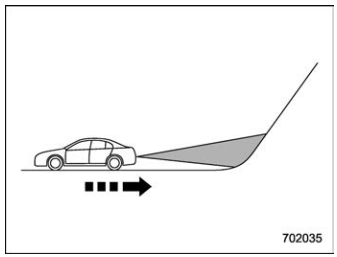
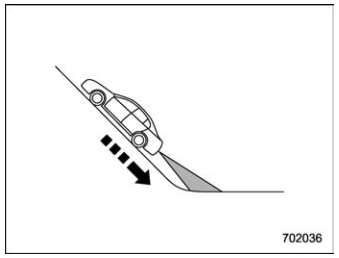
- The path of the reversing direction is inclined such as on a steep uphill.
- A curb is present in the reversing direction.
- When reversing downhill.
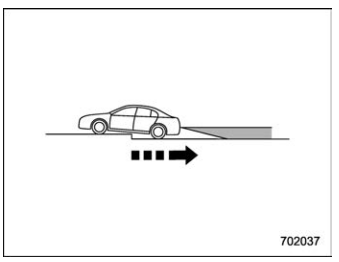
- When reversing on an uneven road.
- In circumstances such as the following,
it may not be possible to avoid a
collision even when the system operates
normally.
- Roads are slippery.
- The tire air pressure is not correct.
- The tires have become worn.
- Tires which are not the designated size are installed.
- Emergency repairs were performed using a puncture repair kit.
- The suspension was modified.
- Tire chains are installed.
- Vehicle driving is unstable due to accident or malfunction.
- The brake warning light is illuminated.
 Detecting range
Detecting range
Detecting range (width): Approximately 6
in (15 cm) outside of ..
 Reverse Automatic Braking (RAB) system operation
Reverse Automatic Braking (RAB) system operation
When the Reverse Automatic Braking
(RAB) system is in operation, the range
between the vehicle and the detected
object will be indicated on the audio/navigation monitor...
Other information:
Subaru Forester 2019-2025 Owners Manual: Front passenger’s SRS frontal airbag
The front passenger’s SRS frontal airbag uses a dual stage inflator. The inflator operates in different ways depending on the severity of impact. Occupant detection system sensors The occupant detection system sensors are installed between the seat and seat rails, and monitor the physique and posture of the front passenger...
Subaru Forester 2019-2025 Owners Manual: Guidance screen
When the INFO button on the steering wheel is pressed and held on this screen, the setting screen can be displayed. For details, refer to “Setting screen”. NOTE When the combination meter display (color LCD) is displaying the menu screen entering screen, the system will not move to the setting screen even if the INFO button is pressed and held...
Categories
- Manuals Home
- Subaru Forester Owners Manual
- Subaru Forester Service Manual
- Reclining the seatback (if equipped)
- Low fuel warning light
- Changing a flat tire
- New on site
- Most important about car
Type B multi-function display (color LCD)
Turn the ignition switch to “ON”.
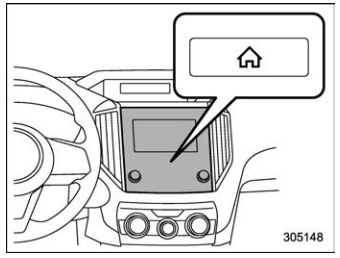
 button.
Select “Settings”.
Select “Vehicle”.
Select “Time/Date” and then select “Manual”.
button.
Select “Settings”.
Select “Vehicle”.
Select “Time/Date” and then select “Manual”.
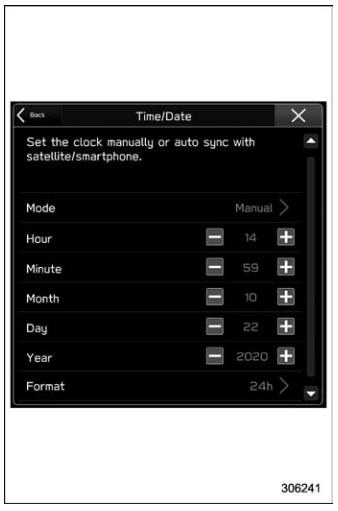
 to complete the
clock
setting.
to complete the
clock
setting.
Copyright © 2025 www.suforester5.com
